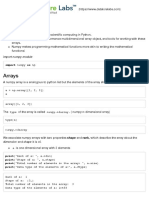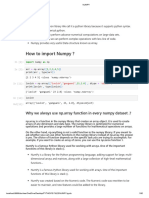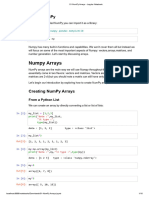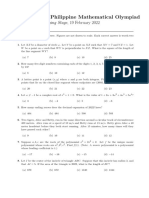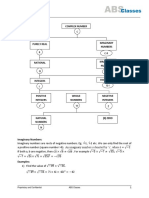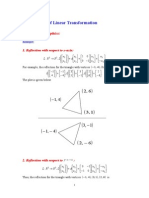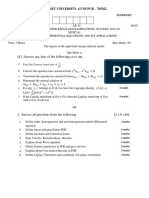01-Numpy-Arrays (3)
March 4, 2024
1 Importing Numpy
[99]: import numpy as np
1.1 Arrays
Why we use Numpy array and not just a list?
• Memory efficient
• Easily expandable to N-dimensions
• Speed of calculations of numpy array
• Broadcasting operations and functions
[100]: lst = [1,2,3]
arr = np.array(lst)
[101]: type(lst)
[101]: list
[102]: type(arr)
[102]: numpy.ndarray
[103]: mat = [[1,2,3],[4,5,6],[7,8,9]]
mat
[103]: [[1, 2, 3], [4, 5, 6], [7, 8, 9]]
[104]: np.array(mat)
[104]: array([[1, 2, 3],
[4, 5, 6],
[7, 8, 9]])
1
� 1.2 Built-in Methods to create arrays
[105]: #arange: return evenly spaces values within a given interval
np.arange(0,10)
[105]: array([0, 1, 2, 3, 4, 5, 6, 7, 8, 9])
[106]: np.arange(0,11,3) # here the last column denotes the step size
[106]: array([0, 3, 6, 9])
1.3 Zeros and Ones : Gives 0 ans 1 matrix
[107]: np.zeros(4)
[107]: array([0., 0., 0., 0.])
[108]: np.zeros((3,4))
[108]: array([[0., 0., 0., 0.],
[0., 0., 0., 0.],
[0., 0., 0., 0.]])
[109]: np.ones((4,2))
[109]: array([[1., 1.],
[1., 1.],
[1., 1.],
[1., 1.]])
1.4 Linspace : Returns equally spaced values
[110]: np.linspace(0,15,5) # here the last column denotes how many numbers you want
[110]: array([ 0. , 3.75, 7.5 , 11.25, 15. ])
[111]: #Eye: gives Identity Matrix
np.eye(5)
[111]: array([[1., 0., 0., 0., 0.],
[0., 1., 0., 0., 0.],
[0., 0., 1., 0., 0.],
[0., 0., 0., 1., 0.],
[0., 0., 0., 0., 1.]])
2
� 2 Random
[112]: #rand: create array of given shape and populates it with random samples from a␣
↪uniform distribution over [0,1)
np.random.rand(9)
[112]: array([0.89460666, 0.08504421, 0.03905478, 0.16983042, 0.8781425 ,
0.09834683, 0.42110763, 0.95788953, 0.53316528])
[113]: np.random.rand(3,4)
[113]: array([[0.69187711, 0.31551563, 0.68650093, 0.83462567],
[0.01828828, 0.75014431, 0.98886109, 0.74816565],
[0.28044399, 0.78927933, 0.10322601, 0.44789353]])
[114]: #randn: return a sample from the standard normal distribution i.e numbers will␣
↪be distributed around 0
np.random.randn(10)
[114]: array([-0.26788808, 0.53035547, -0.69166075, -0.39675353, -0.6871727 ,
-0.84520564, -0.67124613, -0.0126646 , -1.11731035, 0.2344157 ])
[115]: np.random.randn(5,4)
[115]: array([[ 1.65980218, 0.74204416, -0.19183555, -0.88762896],
[-0.74715829, 1.6924546 , 0.05080775, -0.63699565],
[ 0.19091548, 2.10025514, 0.12015895, 0.61720311],
[ 0.30017032, -0.35224985, -1.1425182 , -0.34934272],
[-0.20889423, 0.58662319, 0.83898341, 0.93110208]])
[116]: #randint: return integers from low(inclusive) to high(exclusive)
np.random.randint(1,10)
[116]: 8
[117]: np.random.randint(1,10,15) #excluding 10 here #here the last column denotes␣
↪how many numbers you want
## Also, everytime we run this command, different set of random numbers will be␣
↪generated, so if we want that everytime the same
# set of numbers to be generated then we can use 'Seed'
[117]: array([2, 8, 9, 5, 1, 2, 9, 3, 4, 2, 3, 8, 3, 7, 1])
3
� 2.1 Seed : generates same set of random numbers everytime for a particular
seed number
[118]: np.random.seed(1) #it is same as random_state in Train Test␣
↪split
np.random.randint(1,10,19) # here the last column denotes how many␣
↪numbers you want
# We have to run both the above commands in the same cell, otherwise it won't␣
↪give the same output
[118]: array([6, 9, 6, 1, 1, 2, 8, 7, 3, 5, 6, 3, 5, 3, 5, 8, 8, 2, 8])
2.2 Array attributes and Methods
[119]: arr = np.arange(25)
ranar = np.random.randint(0,50,10)
[120]: arr
[120]: array([ 0, 1, 2, 3, 4, 5, 6, 7, 8, 9, 10, 11, 12, 13, 14, 15, 16,
17, 18, 19, 20, 21, 22, 23, 24])
[121]: ranar
[121]: array([30, 32, 22, 13, 41, 9, 7, 22, 1, 0])
[131]: #reshape
arr.reshape(5,5) #Changes not permanent
[131]: array([[ 0, 1, 2, 3, 4],
[ 5, 6, 7, 8, 9],
[10, 11, 12, 13, 14],
[15, 16, 17, 18, 19],
[20, 21, 22, 23, 24]])
[132]: arr1 = arr.reshape(5,5)
[123]: arr
[123]: array([ 0, 1, 2, 3, 4, 5, 6, 7, 8, 9, 10, 11, 12, 13, 14, 15, 16,
17, 18, 19, 20, 21, 22, 23, 24])
[124]: ranar
[124]: array([30, 32, 22, 13, 41, 9, 7, 22, 1, 0])
[125]: ranar.max()
4
�[125]: 41
[126]: ranar.argmax() #gives at which index the value is maximum
[126]: 4
[127]: ranar.min()
[127]: 0
[128]: ranar.argmin() #gives at which index the value is minimum
[128]: 9
[133]: arr.shape
[133]: (25,)
[129]: arr1.shape
[129]: (5, 5)
[130]: ranar.shape
[130]: (10,)
5
� 02_Numpy_Indexing_Selection (1)
March 5, 2024
[2]: import numpy as np
[3]: arr = np.arange(0,21,2)
arr
[3]: array([ 0, 2, 4, 6, 8, 10, 12, 14, 16, 18, 20])
[4]: arr[4]
[4]: 8
[5]: arr[:7]
[5]: array([ 0, 2, 4, 6, 8, 10, 12])
0.1 Broadcasting
[6]: arr[0:5] = 100
arr
[6]: array([100, 100, 100, 100, 100, 10, 12, 14, 16, 18, 20])
[7]: slice_of_arr = arr[0:5]
slice_of_arr
[7]: array([100, 100, 100, 100, 100])
[8]: slice_of_arr[:] = 99
slice_of_arr
[8]: array([99, 99, 99, 99, 99])
[9]: arr #changes reflects in original array
[9]: array([99, 99, 99, 99, 99, 10, 12, 14, 16, 18, 20])
1
� 0.1.1 In Broadcasting, data is not copied. Its a view of original array. This avoids
memory problems
[10]: arr_copy = arr.copy()
arr_copy
[10]: array([99, 99, 99, 99, 99, 10, 12, 14, 16, 18, 20])
0.2 Indexing a 2D array (Matrices)
[11]: arr_2d = np.array(([5,10,15],[20,25,30],[35,40,45])) #since there are two␣
↪brackets after np.array, it means this is a 2D array!
arr_2d
[11]: array([[ 5, 10, 15],
[20, 25, 30],
[35, 40, 45]])
[12]: arr_2d[1]
[12]: array([20, 25, 30])
[13]: arr_2d[1][1]
[13]: 25
[14]: arr_2d[2][2]
[14]: 45
[15]: arr_2d[2][-1]
[15]: 45
[16]: arr_2d[-1][-1]
[16]: 45
[17]: arr_2d[-1,-1]
[17]: 45
[27]: arr_2d[0:2,1:] #arr[rows,columns]
[27]: array([[10, 15],
[25, 30]])
[19]: arr_2d[1:,:2]
2
�[19]: array([[20, 25],
[35, 40]])
0.3 Conditional selection
[20]: arr = np.arange(1,11)
arr
[20]: array([ 1, 2, 3, 4, 5, 6, 7, 8, 9, 10])
[21]: bool_arr = arr > 4
[22]: arr[bool_arr == False]
[22]: array([1, 2, 3, 4])
[23]: arr[bool_arr]
[23]: array([ 5, 6, 7, 8, 9, 10])
[24]: arr[arr > 7]
[24]: array([ 8, 9, 10])
[25]: x = 10/5
arr[arr>x]
[25]: array([ 3, 4, 5, 6, 7, 8, 9, 10])
3
� 03_Numpy_Operations
March 5, 2024
1 Arithmetic
[1]: import numpy as np
[2]: arr = np.arange(0,10)
arr
[2]: array([0, 1, 2, 3, 4, 5, 6, 7, 8, 9])
[3]: arr+arr
[3]: array([ 0, 2, 4, 6, 8, 10, 12, 14, 16, 18])
[4]: arr*arr
[4]: array([ 0, 1, 4, 9, 16, 25, 36, 49, 64, 81])
[5]: arr-arr
[5]: array([0, 0, 0, 0, 0, 0, 0, 0, 0, 0])
[6]: arr/arr
C:\Users\shrey\AppData\Local\Temp\ipykernel_20396\1862401812.py:1:
RuntimeWarning: invalid value encountered in divide
arr/arr
[6]: array([nan, 1., 1., 1., 1., 1., 1., 1., 1., 1.])
[7]: 1/arr
C:\Users\shrey\AppData\Local\Temp\ipykernel_20396\255282349.py:1:
RuntimeWarning: divide by zero encountered in divide
1/arr
[7]: array([ inf, 1. , 0.5 , 0.33333333, 0.25 ,
0.2 , 0.16666667, 0.14285714, 0.125 , 0.11111111])
[8]: arr**0.5
1
�[8]: array([0. , 1. , 1.41421356, 1.73205081, 2. ,
2.23606798, 2.44948974, 2.64575131, 2.82842712, 3. ])
1.1 Universal array functions
[9]: np.sqrt(arr)
[9]: array([0. , 1. , 1.41421356, 1.73205081, 2. ,
2.23606798, 2.44948974, 2.64575131, 2.82842712, 3. ])
[10]: np.exp(arr)
[10]: array([1.00000000e+00, 2.71828183e+00, 7.38905610e+00, 2.00855369e+01,
5.45981500e+01, 1.48413159e+02, 4.03428793e+02, 1.09663316e+03,
2.98095799e+03, 8.10308393e+03])
[11]: np.cos(arr)
[11]: array([ 1. , 0.54030231, -0.41614684, -0.9899925 , -0.65364362,
0.28366219, 0.96017029, 0.75390225, -0.14550003, -0.91113026])
[12]: np.log(arr)
C:\Users\shrey\AppData\Local\Temp\ipykernel_20396\3120950136.py:1:
RuntimeWarning: divide by zero encountered in log
np.log(arr)
[12]: array([ -inf, 0. , 0.69314718, 1.09861229, 1.38629436,
1.60943791, 1.79175947, 1.94591015, 2.07944154, 2.19722458])
1.1.1 Summary statistics
[16]: arr
[16]: array([0, 1, 2, 3, 4, 5, 6, 7, 8, 9])
[17]: arr.sum()
[17]: 45
[18]: arr.mean()
[18]: 4.5
[19]: arr.max()
[19]: 9
[20]: arr.min()
2
�[20]: 0
[21]: arr.var()
[21]: 8.25
[22]: arr.std()
[22]: 2.8722813232690143
1.2 Axis Logic
• axis 0 denotes the vertical axis
• axis 1 denotes the horizaontal axis
[23]: arr_2d = np.array([[1,2,3,4],[5,6,7,8],[9,10,11,12]])
arr_2d
[23]: array([[ 1, 2, 3, 4],
[ 5, 6, 7, 8],
[ 9, 10, 11, 12]])
[24]: arr_2d.sum(axis = 0 )
[24]: array([15, 18, 21, 24])
[25]: arr_2d.sum(axis = 1 )
[25]: array([10, 26, 42])
3
� 4_Exercises
March 5, 2024
[1]: import numpy as np
[2]: #Create an array of 20 lineraly spaced points between 0 and 1
np.linspace(0,1,20)
[2]: array([0. , 0.05263158, 0.10526316, 0.15789474, 0.21052632,
0.26315789, 0.31578947, 0.36842105, 0.42105263, 0.47368421,
0.52631579, 0.57894737, 0.63157895, 0.68421053, 0.73684211,
0.78947368, 0.84210526, 0.89473684, 0.94736842, 1. ])
[3]: #reshape above array in 4*5 dimension
arr = np.linspace(0,1,20).reshape(4,5)
arr
[3]: array([[0. , 0.05263158, 0.10526316, 0.15789474, 0.21052632],
[0.26315789, 0.31578947, 0.36842105, 0.42105263, 0.47368421],
[0.52631579, 0.57894737, 0.63157895, 0.68421053, 0.73684211],
[0.78947368, 0.84210526, 0.89473684, 0.94736842, 1. ]])
[4]: arr.sum(axis=1)
[4]: array([0.52631579, 1.84210526, 3.15789474, 4.47368421])
[5]: #left bottom 3*3
arr[1:,:3]
[5]: array([[0.26315789, 0.31578947, 0.36842105],
[0.52631579, 0.57894737, 0.63157895],
[0.78947368, 0.84210526, 0.89473684]])



